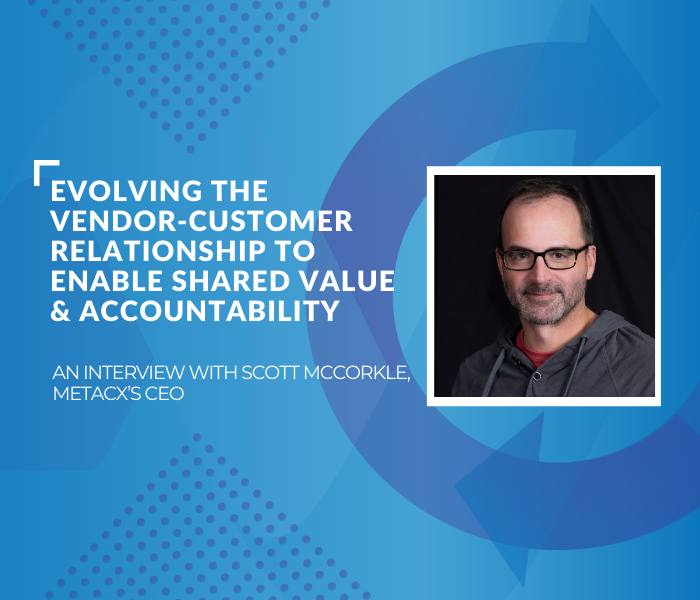Is Your Vendor-Customer Relationship Driving Shared Value Realization?
The economic lifeblood of leading recurring revenue organizations is shared value and accountability. In the modern subscription economy, there’s no escaping shared responsibility for customer value management because the vendor-customer relationship is interdependent and inextricably linked. In order for your organization to successfully align on the expectations of value creation and delivery for customers, you need a thorough strategy and enterprise-grade Customer Success technology that can facilitate shared accountability and collaboration.
To discover how leading B2B technology companies are transforming their approach to customer value management, Valuize’s Founder and CEO, Ross Fulton, spoke to Scott McCorkle, CEO at MetaCX. Through MetaCX, Scott is pioneering a new outcomes-based approach for managing the customer lifecycle by transforming how suppliers and buyers collaborate and win together. Scott has spent his entire career building and commercializing enterprise software which has generated billions of dollars in revenue. In this interview, Scott delves into how the vendor-customer relationship needs to evolve in order to facilitate shared value and accountability and how to leverage technology to drive optimal value realization.
Q: When we talk about value in recurring revenue organizations, it’s something that’s measurable, deliverable and verifiable – it’s distinct from value proposition. What are your thoughts on value as a differentiator?
A: “That’s exactly right – value is more than just a proposition or a positioning statement. Rather, it’s understanding what new capability a buyer needs that’s pushing them to engage in a supplier relationship. The two crucial components of that are the supplier and buyer, both of whom are equally invested in achieving some outcome. Ultimately, that outcome belongs to the buyer; they have a need that they are trying to fulfill by reaching out to a supplier. When you approach that interaction as a vendor, your ultimate goal is to figure out how to capture value. Your organization should be asking: How do we map our product’s capabilities to achieve the customer’s expectations? How do we measure the value being delivered?
We must think of value as being a shared concept that includes both the supplier and the buyer and requires them to gather in a neutral space. If we shift to that mindset, it’s transformational and it takes us into value as something that can actually be measured and achieved in a much more compelling way.”
Q: That concept of shared value extends to shared accountability. Currently, there’s a lack of conversation around accountability on the buyer. What are your thoughts on the current conversations, or lack thereof, around shared accountability?
A: “If we look at the beginning of a supplier-buyer relationship, there is a reason that a buyer reaches out to a supplier and engages in that interaction; there is some capability within their organization that needs to be changed, enhanced, or established. The relationship starts with a buyer articulating what capability they need, followed by a supplier showcasing how their competencies map to that need. There’s no escaping the joint accountability piece because it’s a shared engagement from the very beginning. If you don’t have a platform to operationalize that joint accountability in a collective space, you’re leaving a lot of risks and opportunities on the table.
While organizations are getting business done and advancing relationships based on current capabilities, we all know it can work better – there’s more innovation to come. That’s how these new movements get started as we open our minds and begin to ask: why do we do things the way we do today? What might we do differently or better? We know companies are going to connect and work together, but we have an incredible opportunity to reframe the way that enterprise software investments work to actually support connectivity, collaboration and customer value management. What would it look like if we built a platform ahead of time to facilitate that connection? That’s a big part of what MetaCX does.”
Q: One word to describe the enablement of shared accountability is collaboration. To truly operationalize collaboration in a way that results in value realization for both parties, you need cutting-edge technology and product capabilities. But, this is such an underinvested space in the enterprise technology category. Why do you think that is?
A: “Collaboration has been approached from the perspective of enhancing communication through paradigms like email, posts, statements, and comments. In the world of shared accountability for customer value management, companies need to align on the expectation of value and then measure how that value is being delivered. One step further, the concept of collaboration needs to extend beyond this and into enterprise class software.
Software is made up of a collection of core objects that have workflows designed to make a business come to life. This should be the basis of supplier-buyer collaboration. That level of collaboration is very different from you and I sharing a project plan, having a shared Slack channel, or emailing each other. It is the workflow. In fact, we could argue that we’re enabling a net new workflow, which doesn’t sit within the four walls of a company but rather rises up and out to link companies. So, we’re collaborating in a way that actually facilitates the flow of value. That’s a very different definition of collaboration.”
Q: We generally think of customer value management in the traditional sense, reduction in time or costs, but you’re doing some fascinating work around the concept of social value and how it fits into this category. What are the different kinds of value, including social value, that fall under shared value realization between a supplier and buyer? What are you seeing from other industries that are pioneering this space?
A: “We started MetaCX with the idea of commercial value – companies coming together and engaging in a commercial relationship. It’s been very exciting and energizing to see organizations think of social value and apply our platform for the purpose of aligning their ecosystems on social value. It’s the same pattern of establishing an expectation with your partners or stakeholders in your ecosystem and then measuring how that expectation is being met. Some examples of this could be carbon reduction, clean power, or diverse hiring. Those social values, which are important in their own right, actually do lead to success for companies and influence commercial value. We consider these as equally important to an organization’s value, so it’s very exciting to see our platform being applied to both.
In regards to industry, it’s interesting to see certain verticals like healthcare begin to treat value as the literal determinant of the commercial relationship. For example, a new therapeutic for diabetes control will reduce hospital readmissions and, as that happens, it triggers the economics of the relationship. This is a use case that necessitates the need for a platform that treats suppliers and buyers equally, such that they can define those expectations and then manage them from the data and the signals coming from each organization. I think healthcare is leading in regards to putting value as the determinant of the relationship between payers, providers and suppliers.”
Q: The rise of the recurring revenue business model and its corresponding unit economics convey that shared value is imperative and the industry is starting to wake up to this fact. But, the act of putting value at the heart of the customer lifecycle is still considered fairly advanced in regards to the maturity curve – do you find that to be the case?
A: “Yes, we see companies that have drastic and differing levels of maturity. There are plenty of organizations that aren’t great at positioning value, but are good at selling. The thinking around customer value management will continue to evolve as the proof of performance in a vendor-customer relationship becomes more important and apparent. In short, the companies that aren’t able to clearly define, articulate and be held accountable for value delivery will be at an extreme disadvantage. While these are not new words we’re using, the way we’re starting to talk about value as the center of the relationship between supplier and buyer is revolutionary. I think we’re on the cusp of a movement and at an inflection point; the subscription economy will give way to a performance economy in which the nature of how companies collaborate on this concept of value will change in a really profound way.”
Q: COVID has undeniably impacted the customer-vendor relationship, forcing buyers to reconsider their needs from a supplier and catalyzing this shift into a new type of economy. Do you think COVID has forced this change or has it merely accelerated a transformation that was already underway?
A: “I think there were a number of factors that were well underway, but COVID definitely accelerated the transformation. The pandemic brought in net-new thinking that really advanced things even further, which is apparent when you hear organizations say things like; ‘we needed to activate new expectations in our supply chain, we needed more visibility into supply chain issues, we needed a way to reflect operational priorities that were changing dramatically with our key suppliers or with our key customers’. In general, there was an increased need to align faster with more precision on what is expected of our business relationships. The current state isn’t considered satisfactory, and I think what we’ll see over the next year is how companies respond to and implement new processes, capabilities and tools to address this. Big change is coming, especially in regards to our collective approach to transparency, connectivity, and collaboration.”
Put Customer Value Management At The Center Of Your Vendor-Customer Relationship
With the market and your customers constantly changing, your approach to your customer relationships, and the data used to fuel this engagement, needs to evolve accordingly. To summit this tectonic shift in the buyer-supplier relationship, you need to bring the customer into the value definition, delivery and verification process so that you can co-create success together. Shared value and shared accountability is the only means to achieve optimal value realization for your customers and market-leading retention and expansion for your business.
Listen to Scott’s full interview on the Customer Valuecast podcast for a deeper dive into how you can champion the new vendor-customer relationship centered on collaboration, shared value and accountability in your organization to drive maximum retention and expansion.





